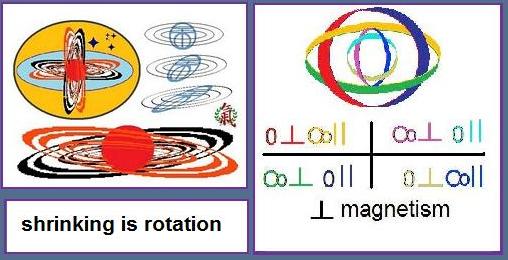

Anorthogon-Orthogon Quasi-twistor Theory L. Edgar Otto Aug. 24, 2011
I present this, for those who have followed the arguments, many of which are embarrassingly a return to my first thoughts on geometry and physics just before adulthood, almost without explanation and as a mere appendix or footnote for the sake of completion. It is of course obvious that if we compute the corner of dimensional objects and there is a duality of points and lines, faces and so on, that we have to consider more involved in the coloring and commutative results for the structures and possibilities.
Primitive Quasistars are also a concept that adds the points and connections between hierarchies of objects much like in the fractal conceptions as a concept that led to the quasic space and the centrality of inversions. I mean what forbids an inverse or a quadrapole logic of inverses of say 1 over the p-adic values... or the inverse square law... or some deal that in the Fibonacci series can determine from the order which is the prime number or which is the subscript as prime? The quasistars of course follow the constructable directions of which these follow Pascal numbers.
P-adics in TGD in a sense quantizes the distribution of mass as this very difference between the three polyhedral spaces and their motives of which are corresponding so quantized (but not simply by affixing a duality cyclic group to some other group.) So the qlassical x quantum is the quasication such that we do not necessarily need a much deeper explanation for say mass or gravity than what is on this low range of dimensional structures and levels.
The idea of these alphanumerics is thus established as the metaphysics of iota 0 and 1 where these foundation-ally apply to extended theories. So the idea of a matrix as more of a plastic entity that actually maps almost as an identity with the physical as in the mass of an entity should be as fluid and alive as this entity. The order derived in the illustration was after all a setting of certain Pascal analog numbers of the orthogons and manipulating these values of which the shifting of diagonals and rows and columns means the shift from orthogon to anorthogon. We also may merge the 30 cube graph that they make 25 (as in the 25 particle standard model including Higgs. We change the oblong to the square by merging the elements in the matrix of unitary value and excluding the zeros and the main diagonal that contains them.
These numbers for the record add up to 211 or 237 as the case may be.
(237 + 211)divided by 8 = 448 or 7x8x8, 8 x 56 for you braiding enthusiasts. And 448 + 64 + 512.
From the view of simplexes (triangle like dimensional things) the computation of points and faces of regular solids in this case 6 things taken four or two at a time symmetric across Pascal binomial expansion applies where self dual. In the illustration pi is for pion more like TGD and my early concepts, G for gravity, m for mass... and on this simple projective dualism level we find mass or gravity, and as we can intelligibly combine these Platonic objects it is clear that over a short range sometimes the connectors need to have inverse orientation of the faces between them. Note also that the cube is three tetrahedra and the octahedron is four for such considerations in counting. The half value is the real part of the zeta function consideration across the range between the zero to one iota vectors.
* * *


No comments:
Post a Comment